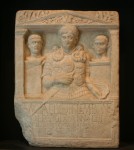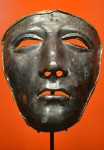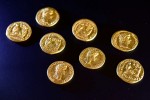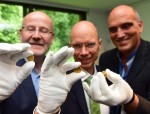 At the Battle of Teutoburg Forest in 9 A.D., three legions, six cohorts of auxiliary troops and three squadrons of cavalry led by Publius Quintilius Varus were slaughtered by Germanic tribesmen led Arminius. Arminius was the son of Cherusci king who had been sent to Rome as a hostage when he was a child. There he received a military education and achieved the rank of Equites. He was deployed to Germania as Varus’ advisor where he secretly united tribes that had been at each other’s throats for years. While feeding Varus misinformation, Arminius used his knowledge of Roman military tactics to manipulate commander and legions into a disastrously indefensible position inside the forest. By the end of the battle, 15,000 to 20,000 Roman troops were dead. Varus and several of his officers committed suicide. Only about 1,000 men survived.
At the Battle of Teutoburg Forest in 9 A.D., three legions, six cohorts of auxiliary troops and three squadrons of cavalry led by Publius Quintilius Varus were slaughtered by Germanic tribesmen led Arminius. Arminius was the son of Cherusci king who had been sent to Rome as a hostage when he was a child. There he received a military education and achieved the rank of Equites. He was deployed to Germania as Varus’ advisor where he secretly united tribes that had been at each other’s throats for years. While feeding Varus misinformation, Arminius used his knowledge of Roman military tactics to manipulate commander and legions into a disastrously indefensible position inside the forest. By the end of the battle, 15,000 to 20,000 Roman troops were dead. Varus and several of his officers committed suicide. Only about 1,000 men survived.
The defeat was so decisive it had long-term consequences to Rome’s plans for Germania. Roman legions would fight German tribes east of the Rhine, even east of the Teutoburg Forest again, but Rome never gained the permanent foothold in Germany between the Rhine and the Elbe it had in Gaul or Britain.
 The precise location of the battlefield was lost for thousands of years until the late 1980s when a metal detectorist found coins from the reign of Augustus and lead sling-bullets at Kalkriese Hill in Osnabrück county, Lower Saxony. Starting in 1989, the site was formally excavated and archaeologists unearthed human and animal bones, and Roman military artifacts like fragments of hobnailed sandals, spearheads, iron keys and one officer’s ceremonial face mask. They also found earthworks defenses 15 miles wide and evidence that the Romans had attempted to breach them but failed, just as Cassius Dio had described (Roman History, Book 56, Chapter 18).
The precise location of the battlefield was lost for thousands of years until the late 1980s when a metal detectorist found coins from the reign of Augustus and lead sling-bullets at Kalkriese Hill in Osnabrück county, Lower Saxony. Starting in 1989, the site was formally excavated and archaeologists unearthed human and animal bones, and Roman military artifacts like fragments of hobnailed sandals, spearheads, iron keys and one officer’s ceremonial face mask. They also found earthworks defenses 15 miles wide and evidence that the Romans had attempted to breach them but failed, just as Cassius Dio had described (Roman History, Book 56, Chapter 18).
A museum and archaeological park were built at Kalkriese Hill in the early 2000, with the 20 hectares of the site open to the public as excavations continue. During this season’s excavation, a team from the Kalkriese Museum and Park and Osnabrück University found six gold coins, Augustan aurei, on June 9th. The next day they found three more. In the past 25 years, excavations at the site have unearthed two gold coins and 800 silver and bronze ones, so finding eight within a few meters of each other on two consecutive days is a great rarity.
 Minted in Lugdunum (modern-day Lyons) from 2 B.C. until 4 A.D., the aurei are of the Gaius-Lucius type, coins dedicated to Augustus’ grandsons. On the reverse the young Caesars are depicted wearing togas, one hand on a shield with a spear behind it. A simplum and lituus, emblems of priestly rank, hover between them. The inscription reads AVGVSTI F COS DESIG PRINC IVVENT (“sons of Augustus, consuls-designate and leaders of the youth”). The obverse is a profile head of Augustus wearing a laurel wreath inscribed CAESAR AVGVSTVS DIVI F PATER PATRIAE (“Caesar Augustus, son of the deified [Julius Caesar], Father of the Nation”).
Minted in Lugdunum (modern-day Lyons) from 2 B.C. until 4 A.D., the aurei are of the Gaius-Lucius type, coins dedicated to Augustus’ grandsons. On the reverse the young Caesars are depicted wearing togas, one hand on a shield with a spear behind it. A simplum and lituus, emblems of priestly rank, hover between them. The inscription reads AVGVSTI F COS DESIG PRINC IVVENT (“sons of Augustus, consuls-designate and leaders of the youth”). The obverse is a profile head of Augustus wearing a laurel wreath inscribed CAESAR AVGVSTVS DIVI F PATER PATRIAE (“Caesar Augustus, son of the deified [Julius Caesar], Father of the Nation”).
The sons of Augustus’ daughter Julia and Marcus Agrippa, Gaius and Lucius were adopted by their grandfather in 17 B.C. when Gaius was three and Lucius was an infant. He made them his heirs and turbocharged them into political careers when they were still teenagers. Augustus’ hopes were dashed when Lucius died of a sudden illness in 2 A.D. and Gaius died two years later after being wounded in battle. Tacitus suggests their stepmother Livia may have had a hand in their deaths in order to elevate her own son Tiberius to the imperial throne.
 After Gaius’ death in 4 A.D., the coins were no longer produced. The eight coins found on the battle site are well-preserved, but they show signs of having been in circulation, particularly in the wear around the edges. Aurei were very valuable, used mainly for large purchases and ceremonial gifts. Standard legionary pay under Augustus was 300 bronze asses a month, the equivalent of about 19 denarii. An aureus was worth 25 denarii. Legionaries didn’t usually get their full pay while they were in the field because carrying around increasing hundreds of bronze coins for years quickly goes from bulky to impossible. It was saved for when the campaign was over or sent to their families.
After Gaius’ death in 4 A.D., the coins were no longer produced. The eight coins found on the battle site are well-preserved, but they show signs of having been in circulation, particularly in the wear around the edges. Aurei were very valuable, used mainly for large purchases and ceremonial gifts. Standard legionary pay under Augustus was 300 bronze asses a month, the equivalent of about 19 denarii. An aureus was worth 25 denarii. Legionaries didn’t usually get their full pay while they were in the field because carrying around increasing hundreds of bronze coins for years quickly goes from bulky to impossible. It was saved for when the campaign was over or sent to their families.
Only an officer was likely to have the wherewithal to have a bunch of aurei on his person. Since these coins were found so close together and relatively near the surface, archaeologists believe they may have been in a bag of cash an officer was carrying during the battle. It was dropped in the conflict or perhaps hidden before a flight attempt and the bag decayed, leaving only its shiny contents to be discovered 2,000 years later.
The historical narrative behind the discoveries lends gripping drama and immediate connection with the past. Thank you so much, Livius.
The Kalkriese battlefield as one of the places of Varus’ defeat is not improbable, and apparently it took three days to finish off his three Roman legions. There seems to be, however, a wider context and different tribes and/or ‘peoples’, plus a whole set of different cooperating, but more often opposing warlords, of which -like ‘Arminius’- some had been hosted in their youth as Roman hostages.
In 15AD, “six years after the fatal field, a Roman army, present on the ground, buried the bones of the three legions. […] At the erection of the funeral-mound the Caesar laid the first sod, paying a dear tribute to the departed, and associating himself with the grief of those around him” (Tacitus).
There were battles in 15/16 AD with the involvement of Arminius in the area, e.g. the battle at the ‘pontes longi’ or ‘long bridges’ -a “causeway, running through a wilderness of marshes”- with ten to fifteen thousand Roman casualties, the battle of the Weser River (‘Battle of Idistavisus’) and the battle at the ‘Wall of the Angrivarii’ (an “earthen barrier to mark the boundary to the Cherusci”).
‘Maroboduus’, for example, had returned to Germany in 9 BC and became ruler of the Marcomanni, which he lead from the Northern Bavarian Moenus river, away from advancing Romans, into what is now Bohemia. In 6 AD, Augustus wanted to destroy his kingdom and Tiberius commanded twelve legions to attack them, but the outbreak of a revolt in Illyria forced Tiberius to conclude a treaty.
Marcus Velleius Paterculus (ca.19 BC – ca. 31 AD), who served for eight years (from AD 4-12) in Germany and Pannonia under Tiberius(‘Bellum Batonianum’, AD 6 to 9) writes: “The body of Varus, partially burned, was mangled by the enemy in their barbarity; his head was cut off and taken to Maroboduus, but Maroboduus sent it to Augustus” (Roman History, Book 2, 119,5).
I’ve heard about this battle before, but don’t really know any details. This article is so interesting! Am going to do some research to learn more about it all.
It’s really fascinating! After reading this, I’ve put my blu-ray of the second season of ROME in the player and am about to watch it…love that show!
:yes:
Right NOW taking place, European Soccer Championship, 2nd Half:
———
“Germans vs. Romans (and others from Italy)”.
———
So far undecided yet, whose head will be sent home …
Just the first paragraph has the marks of a fascinating movie.
Is it Publius Quintilius Varus or Publius Quinctilius Varus? My sources don’t consistently agree.
Thank you for taking us back to the forest. I’m fascinated by this battle and appreciate the new finds.
Multas Gratias ago tibi!
——–
quinque = 5 , quin(c)tus = the 5th
——–
Both forms are correct. As far as I can tell, ‘quinctus’ or ‘Quinctilius’ seems to be the more traditional form, whereas by 9AD ‘quintus’ or ‘Quintilius’ seems to have been commonly used.
– Pax tibi et vobiscum :hattip: